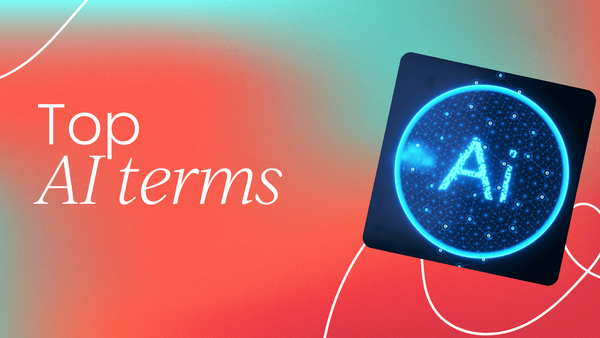Imagine if I earned a dollar every time "AI" popped up in conversation – I’d be sunbathing on a tropical island by now! But seriously, artificial intelligence (AI) is everywhere these days, from coffee chats to business meetings.
As AI shapes industries and redefines the future, understanding key concepts is crucial to stay ahead. Whether you’re creating personalized experiences, driving innovation, or just want to sound savvy in your next AI discussion, these terms are your gateway to unlocking AI’s full potential.
The challenge? Cutting through tech jargon to understand what everyone’s talking about. As an engineer turned product marketer, I’m all about making complex terms simple and relatable.
So, let’s dive in and demystify the AI buzzwords you need to know!
Let's simplify AI
Artificial intelligence (AI)
AI is all about giving machines the ability to think and learn like humans. It mimics human cognitive functions like learning, problem-solving, and pattern recognition.
From chatbots to voice assistants, AI is driving innovation across various technologies. It’s like giving computers a brain to help us solve complex problems and automate tasks.
By 2025, AI is projected to drive global software market revenue to around $126 billion, opening up endless possibilities in fields like healthcare, entertainment, and transportation.
The building blocks: How AI thinks and learns
At its core, AI empowers machines to mimic human intelligence. This foundation is built on:
Machine Learning (ML)
Machine learning is a subset of AI where computer systems improve their performance on tasks over time by learning from data. It’s the backbone of many AI applications like recommendation systems and predictive analytics, helping systems get smarter as they go.
Deep learning
Deep learning is a more advanced type of machine learning that uses neural networks with many layers (hence "deep") to analyze data and make predictions.
It’s especially useful for tasks like image and speech recognition and powers technologies like self-driving cars.
Perceiving the world: How AI sees and hears the world
For AI to interact with the world, it needs to perceive it. These capabilities are essential for AI to interact effectively.
Natural Language Processing (NLP)
NLP allows machines to understand and generate human language. It’s the tech behind chatbots, virtual assistants, and those super-smart email filters. For us, NLP means creating more personalized and engaging customer experiences and tailoring our messaging like never before.
Large Language Models (LLM)
LLMs are AI systems trained on vast text datasets to generate and understand human-like language. They’re essential for making chatbots and virtual assistants sound more natural and engaging.
Computer vision
Ever wondered how AI can "see" and understand images? That’s computer vision in action.
Computer vision trains AI to process and understand visual information, allowing AI to recognize objects, faces, and even emotions in images and videos. It’s a game-changer for us in marketing, helping us analyze visual content and understand customer sentiment at a deeper level.
Creating and innovating
AI is not just about understanding; it's about creating, innovating, and adapting.
This is where the magic happens:
Generative AI
Generative AI is the technology that’s turning science fiction into reality. Unlike traditional AI, which analyzes data and makes predictions, generative AI creates new content from scratch. Whether it’s writing text, designing visuals, composing music, or even generating code, generative AI is like a creative partner that never runs out of ideas.
Generative AI is already making waves in industries like entertainment, where it’s being used to create realistic CGI characters, and in fashion, where it’s helping designers come up with new patterns and styles.
For product marketers, this technology offers a way to rapidly prototype ideas, personalize customer experiences, and even explore entirely new forms of creative expression. It’s like having a mini creative agency in your back pocket!

Reinforcement learning
Reinforcement learning is AI’s way of learning from mistakes. It’s a type of ML where an AI agent learns through trial and error, making decisions and refining its approach – powering everything from self-driving cars to personalized recommendations.
Putting AI to work
To realize AI's potential, we need practical applications. AI agents are not a new concept, but they have taken the field of artificial intelligence by storm in the past year.
AI agents
AI agents are autonomous programs that perform tasks without human intervention.
Common examples include customer service chatbots, virtual personal assistants like Apple's Siri or Google Assistant, and automated trading systems in finance. The newly launched SearchGPT is redefining search by blending search and conversation, challenging traditional engines like Google and Bing.
Building and maintaining AI: The ecosystem
For AI to thrive, a supportive ecosystem is essential.
Behind the scenes, these technologies ensure AI operates seamlessly:
Accelerated computing
Think of accelerated computing as the high-octane fuel that makes AI engines run faster and more efficiently. Traditional computing relies heavily on CPUs (central processing units), which are great for general tasks but can hit bottlenecks when processing massive amounts of data.
Enter GPUs (graphics processing units) and other specialized hardware like TPUs (tensor processing units), which are designed to handle parallel processing tasks at lightning speed.
Accelerated computing uses these specialized processors to turbocharge AI workloads, enabling faster data processing, more complex simulations, and real-time analytics.
RAG (Retrieval-augmented generation)
RAG combines two AI strengths: finding the right information and generating useful content. It improves how large language models (LLMs) work by pulling in relevant data or documents to help answer questions or complete tasks.
Here's how it works: When you ask a question, RAG first goes on a quick "data hunt," pulling in the most relevant documents or pieces of information that might help answer your question. It then uses this fresh info as context to generate a response.
This approach is super handy for tasks where the AI needs to be accurate and current, like in customer support chatbots or Q&A systems that deal with specialized topics.
- AIOps (Artificial Intelligence for IT Operations): AIOps leverages AI to enhance IT operations by automating and optimizing processes. For example, it can predict and resolve service outages or automate repetitive tasks, thus improving system efficiency and reliability.
- MLOps (Machine Learning Operations): MLOps ensures the smooth deployment and maintenance of machine learning models in production. It combines ML, DevOps, and data engineering principles to manage the whole lifecycle of machine learning systems, allowing teams to release reliable models efficiently.
AIOps and MLOps: The dynamic duo
Together, they keep everything running smoothly behind the scenes, freeing us up to focus on the fun, creative parts of our jobs.
Open Source Software (OSS)
OSS is like a community potluck where everyone contributes. OSS involves software development where the source code is open for anyone to use, modify, and enhance.
This community-driven approach accelerates innovation, making advanced tools accessible to developers worldwide.
So there you have it – the essential AI terms, simplified and explained. With this knowledge, you can confidently engage in AI discussions, ready to impress and connect.
But this is just the beginning – AI is constantly evolving, with new trends and technologies to explore. Follow me on LinkedIn for more insights as I dive deeper into how AI is shaping our world. Keep learning and stay curious – AI is the future, and it's happening now!


















 Follow us on LinkedIn
Follow us on LinkedIn




.svg?v=176eabd947)